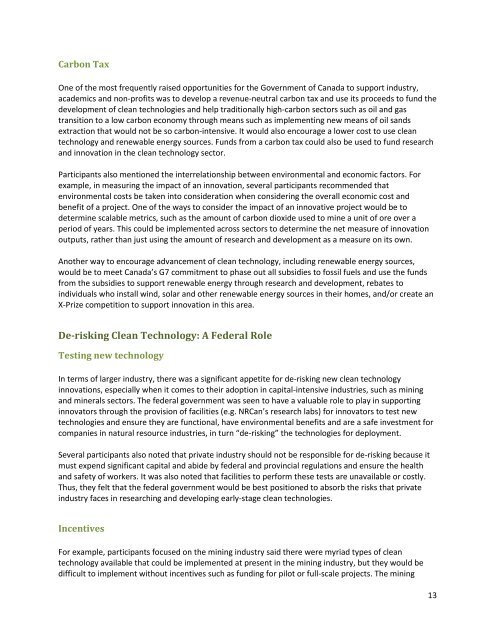LetsTalkCleanResources.ca
NGOQ307nOGf
NGOQ307nOGf
Create successful ePaper yourself
Turn your PDF publications into a flip-book with our unique Google optimized e-Paper software.
Carbon Tax<br />
One of the most frequently raised opportunities for the Government of Canada to support industry,<br />
a<strong>ca</strong>demics and non-profits was to develop a revenue-neutral <strong>ca</strong>rbon tax and use its proceeds to fund the<br />
development of clean technologies and help traditionally high-<strong>ca</strong>rbon sectors such as oil and gas<br />
transition to a low <strong>ca</strong>rbon economy through means such as implementing new means of oil sands<br />
extraction that would not be so <strong>ca</strong>rbon-intensive. It would also encourage a lower cost to use clean<br />
technology and renewable energy sources. Funds from a <strong>ca</strong>rbon tax could also be used to fund research<br />
and innovation in the clean technology sector.<br />
Participants also mentioned the interrelationship between environmental and economic factors. For<br />
example, in measuring the impact of an innovation, several participants recommended that<br />
environmental costs be taken into consideration when considering the overall economic cost and<br />
benefit of a project. One of the ways to consider the impact of an innovative project would be to<br />
determine s<strong>ca</strong>lable metrics, such as the amount of <strong>ca</strong>rbon dioxide used to mine a unit of ore over a<br />
period of years. This could be implemented across sectors to determine the net measure of innovation<br />
outputs, rather than just using the amount of research and development as a measure on its own.<br />
Another way to encourage advancement of clean technology, including renewable energy sources,<br />
would be to meet Canada’s G7 commitment to phase out all subsidies to fossil fuels and use the funds<br />
from the subsidies to support renewable energy through research and development, rebates to<br />
individuals who install wind, solar and other renewable energy sources in their homes, and/or create an<br />
X-Prize competition to support innovation in this area.<br />
De-risking Clean Technology: A Federal Role<br />
Testing new technology<br />
In terms of larger industry, there was a signifi<strong>ca</strong>nt appetite for de-risking new clean technology<br />
innovations, especially when it comes to their adoption in <strong>ca</strong>pital-intensive industries, such as mining<br />
and minerals sectors. The federal government was seen to have a valuable role to play in supporting<br />
innovators through the provision of facilities (e.g. NRCan’s research labs) for innovators to test new<br />
technologies and ensure they are functional, have environmental benefits and are a safe investment for<br />
companies in natural resource industries, in turn “de-risking” the technologies for deployment.<br />
Several participants also noted that private industry should not be responsible for de-risking be<strong>ca</strong>use it<br />
must expend signifi<strong>ca</strong>nt <strong>ca</strong>pital and abide by federal and provincial regulations and ensure the health<br />
and safety of workers. It was also noted that facilities to perform these tests are unavailable or costly.<br />
Thus, they felt that the federal government would be best positioned to absorb the risks that private<br />
industry faces in researching and developing early-stage clean technologies.<br />
Incentives<br />
For example, participants focused on the mining industry said there were myriad types of clean<br />
technology available that could be implemented at present in the mining industry, but they would be<br />
difficult to implement without incentives such as funding for pilot or full-s<strong>ca</strong>le projects. The mining<br />
13


